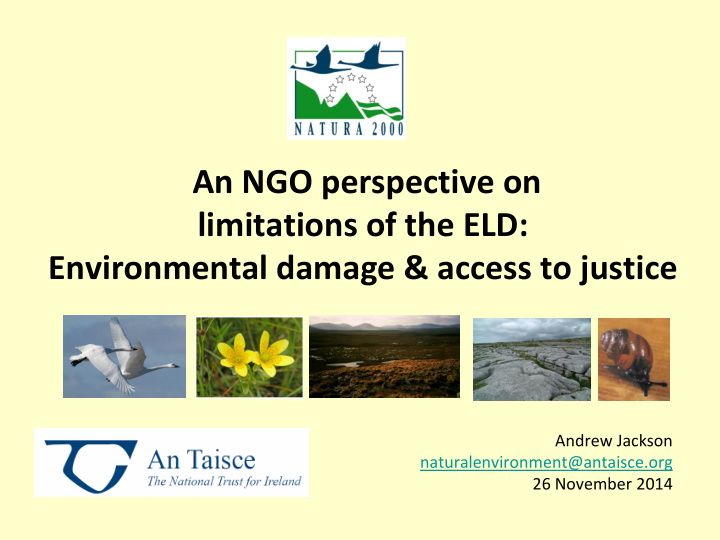



An NGO perspective on limitations of the ELD: Environmental damage & access to justice Andrew Jackson naturalenvironment@antaisce.org 26 November 2014
Point 1: “Environmental damage” • Environmental Liability Directive (ELD): Potentially seriously weakened, insofar as protected species and habitats are concerned, by its definition of environmental damage: “any damage that has significant adverse effects on reaching or maintaining the favourable conservation status of such habitats or species.” • What is the geographic scale? “Favourable conservation status” is a concept which is assessed at the national level . • If such an interpretation is accepted, the implications in terms of the scope/effectiveness of the ELD (Art. 1: “to prevent and remedy environmental damage”; polluter pays) are clear. Purposive approach: local/site-level impacts must also be captured by the ELD.
Case 1: Damage widespread at national scale Peat extraction in active raised bog Natura 2000 sites Digger Digger loads peat into Peat is spread to dry spreading machine for burning in winter
Fuel for domestic heating This is an issue in Ireland in >20 of 53 active raised bog (priority habitat) Natura 2000 sites.
Mouds Bog SAC Co. Kildare “...there has been a 99% loss of the original area of actively growing raised bog in Ireland, and one-third of the remaining 1% has been lost in the last 10 years” (CBD, 2010) Priority habitat Natura 2000 site
Ballynafagh Bog SAC, Co. Kildare Priority habitat Natura 2000 site “Unless urgent steps are taken...Ireland is in danger of losing these invaluable habitats...” (NPWS, 2006)
Case 2: A single example (from earlier this year) Priority habitat turlough SAC in Co. Galway
700+ people’s sewage piped daily into SAC
Action under ELD • Ireland’s EPA is the competent authority for ELD purposes. • We have not seen effective action under the ELD on either of these issues (preventive action or remedial action), despite multiple formal requests for action under the ELD. • Case 1 (Peat extraction within Natura 2000 sites): Realpolitik of ELD enforcement in politically sensitive case? The damage doesn’t in all cases involve an “occupational activity”. • But what about Case 2 (Sewage discharged to Natura 2000 site) ? Should be captured by ELD. • What can one do at the national level about ELD decisions which one regards as legally flawed/ineffective? (Perhaps Member State has conservative regulator; Competent ELD authority vs. public authority cases, etc.)
Point 2: ELD does not provide for access to justice • E.g. Response from Ireland’s EPA re sewage case • Damage to protected species and habitats • But cf. Annex I ELD (criteria to be taken into account in assessing damage to protected species and habitats): “Damage with a proven effect on human health must be classified as significant damage.” • So the damage is surely significant(?) – perceived problem must therefore be adverse effects on favourable conservation status (question of scale)? Cannot be the correct/lawful approach – cf. purposive nature of EU law.
ELD does not provide for access to justice, cont. • Water damage
Access to justice, cont. • Article 9 of the Aarhus Convention requires members of the public to have access to administrative or judicial procedures to challenge acts and omissions by private persons and public authorities which contravene provisions of its national law relating to the environment. • These procedures must not be “prohibitively expensive”. • But challenging an EPA decision under the ELD could easily bankrupt an individual or NGO in Ireland if the case is not successful (e.g. costs of >EUR 100k). Simply too risky. • No equivalent to Article 11 of the EIA Directive in the ELD. • We need the long-promised EU Access to Justice Directive.
Recommend
More recommend